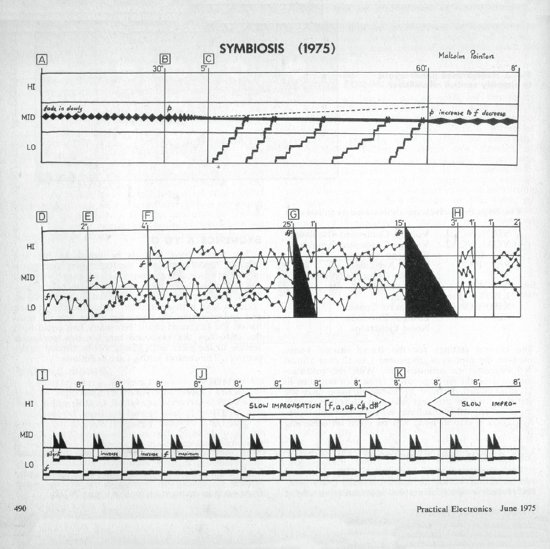release rationale:
"In 1975 hobbyist magazine Practical Electronics published a feature on Symbiosis, an electronic music composition by Malcolm Pointon, designed for realisation by readers via a graphic score.

The piece was developed to augment the Minisonic synthesizer construction project, and stimulate builders and enthusiasts to explore their synths and use them for creative music-making.
During research for the book Tape Leaders, and the Malcolm Pointon anthology Electromuse, Ian Helliwell discovered two versions of Symbiosis recorded in the 1970s, and decided to tackle the piece with his own self-built equipment. This was the catalyst for inviting a number of fellow electronic music-makers to also follow the instructions and create new recordings, resulting in Project Symbiosis. Alongside Malcolm Pointon’s original, nine other versions interpreting the graphic score make up the compilation."
News of Public Information emerging from hibernation to issue an album of interpretations of Pointon's graphic score involving bods like Graham Massey .... alerted me to the fact that I seemed to have missed the whole album of Malcolm's work that Public Information put out in 2016 ....
(or did I in fact post about this at the time?... the fog of recent-past amnesia strikes again! .... at any rate, well worth your and my attention, a second time or for the first time)
release rationale
"..the Symbiosis piece by Malcolm Pointon was very interesting and is the kind of use synthesizers should be put to. Synthesizers should explore new sounds rather than imitate conventional ones..." Practical Electronics Magazine c.1975
Malcolm Pointon was born in 1940, Stoke on Trent. He spent his life and career in tape, synthesizer and keys; academia, sound, music and machine. Here, for the first time, Public Information and Ian Helliwell present the rarely heard works of Malcolm Pointon. With permission given by Malcolm’s widow Barbara, Helliwell has compiled an LP of material taken from master tapes of home-recorded, never released electronic material.
Following a period at the BBC, Malcolm joined Homerton College, Cambridge, in 1969 and it was here where he would discover his electronic-muse. Inspired by Stockhausen and the surge of avant-garde tape music, Malcolm began to build compositions at home using a 4-waveband radio and multi-speed tape recorder. His first piece using these techniques is the skittering “Radiophonie” which opens this LP.
After mastering tape-music, Malcolm began reading, and eventually contributing to, Practical Electronics magazine (edited by our own F.C. Judd no-less). He and engineer cohort Doug Shaw entered an “electronic music construction challenge” in 1973 – and so a battery powered, stylus activated self-build synthesizer was presented to the dedicated circuit heads of Practical Electronics. The Minisonic was born.
Many of the pieces on here were produced using the Minisonic, including the staggeringly heavy centerpiece of this album “Symbiosis” - replete with Malcolm’s own introduction. Elsewhere, Pointon takes us down pummeling arpeggiated rhythms (“Sonata Elletronica), mind-melting-inside-beehive tape pieces (“Poreira”, “Boogie”), freaked-out concrète trips (“Trojan Woman” “Then Wakes the Ice”) and shimmering noise works like the beautiful, “Study 2”.
Malcolm Pointon would be cruelly diagnosed with Alzheimer’s at the age of 51. He became unable to operate his studio and so his rare gift to electronic music was gone, until now. Public Information and curator Ian Helliwell are incredibly proud to share Malcolm’s music with you. We will be sending all profits of this release to the Alzheimer’s Society, helping to support people with dementia and their carers on their long journey, right here and now.
No comments:
Post a Comment